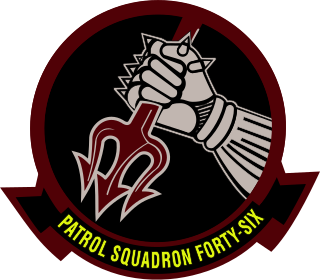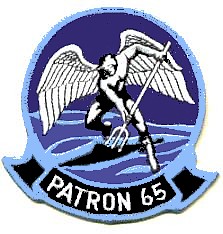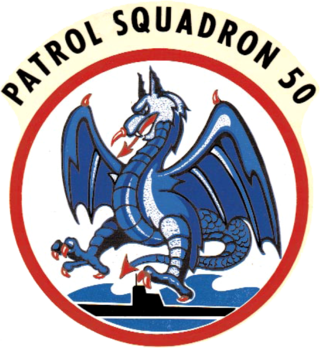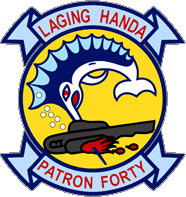
Naval Air Station Whidbey Island (NASWI) is a naval air station of the United States Navy located on two pieces of land near Oak Harbor, on Whidbey Island, in Island County, Washington.
A Patrol Wing (PatWing) was a United States Navy aviation unit with the commander of a Patrol Wing known as the Commodore, the ComPatWing or COMPATWING. From 1 November 1942 to 30 June 1973 Patrol Wings were designated "Fleet Air Wings". On 26 March 1999 all then existing Pacific Fleet Patrol Wings were redesignated Patrol and Reconnaissance Wings and on 1 June 1999 all then existing Atlantic Fleet Patrol Wings were redesigned Patrol and Reconnaissance Wings with the Commodore designated as COMPATRECONWING or ComPatReconWing.

VP-23, Patrol Squadron 23, known as the Seahawks, was a U.S. Navy fixed-wing, anti-submarine and maritime Patrol Squadron based at Brunswick Naval Air Station, Brunswick, Maine, United States. It was established as Weather Reconnaissance Squadron Three (VPW-3) on 17 May 1946, redesignated as Meteorology Squadron Three (VPM-3) on 15 November 1946, redesignated Heavy Patrol Squadron (Landplane) Three (VP-HL-3) on 8 December 1947, and to Patrol Squadron Twenty Three (VP-23) on 1 September 1948 and disestablished on 28 February 1995. It was the second squadron to be designated VP-23, the first VP-23 was redesignated Patrol Bombing Squadron 23 (VPB-23) on 1 October 1944 and disestablished on 25 January 1946.

Patrol Squadron 46 (VP-46), also known as the "Grey Knights", is a maritime patrol squadron of the United States Navy based at Naval Air Station Whidbey Island, Washington. Part of Patrol and Reconnaissance Wing Ten, VP-46 is the oldest maritime patrol squadron and the second oldest aircraft squadron in the entire U.S. Navy, second only behind VFA-14.

Patrol Squadron 47 (VP-47), also known as "The Golden Swordsmen", is a maritime patrol squadron of the United States Navy based at Naval Air Station Whidbey Island, Washington (USA), attached to Patrol and Reconnaissance Wing 10. The squadron currently flies the Boeing P-8A Poseidon.

Patrol Squadron Four (VP-4) is a U.S. Navy land-based patrol squadron based at the Naval Air Station Whidbey Island, Oak Harbor, Washington, which is tasked to undertake maritime patrol, anti-submarine warfare (ASW), and intelligence, surveillance and reconnaissance (ISR) missions flying the Boeing P-8 Poseidon.

Patrol Squadron 9 (VP-9) is a U.S. Navy patrol squadron with its homeport located at Naval Air Station Whidbey Island. As of 2018, VP-9 is part of Patrol and Reconnaissance Wing Ten, Commander, Naval Air Forces, Pacific.

VP-65, nicknamed the Tridents, was a Patrol Squadron of the U.S. Navy Reserve. The squadron was established on 16 November 1970 at NAS Los Alamitos, California, and moved on 6 January 1971 to NAS Point Mugu. It was disestablished on 4 March 2006, after 35 years of service. Elements of the squadron made 22 major overseas deployments.

VP-67 was a Patrol Squadron of the U.S. Navy Reserve. The squadron was established on 1 November 1970 at NAS Memphis, Tennessee, where it was based for its entire life. It was disestablished on 30 September 1994, after 24 years of service. The squadron's nickname was the Golden Hawks, also unofficially called the Thunder Chickens. Elements of the squadron made 23 major overseas deployments.

VP-6 was a long-lived Patrol Squadron of the U.S. Navy, nicknamed the Blue Sharks. Originally established as Bombing Squadron VB-146 on 15 July 1943, it was redesignated Patrol Bombing Squadron VPB-146 on 1 October 1944, redesignated VP-146 on 15 May 1946, redesignated Medium Patrol Squadron (Landplane) VP-ML-6 on 15 November 1946, redesignated VP-6 on 1 September 1948 and disestablished on 31 May 1993. It was the third squadron to be designated VP-6, the first VP-6 was disestablished on 3 May 1926 and the second VP-6 was disestablished on 20 June 1945.

VP-48 was a long-lived Patrol Squadron of the U.S. Navy, nicknamed the Boomerangers from 1975 to 1980, and the Boomers from 1981 to 1991. It was established as Reserve Patrol Squadron VP-905 in May 1946, redesignated Heavy Patrol Squadron (Landplane) VP-HL-51 on 15 November 1946, redesignated VP-731 in February 1950, redesignated VP-48 on 4 February 1953 and disestablished on 23 May 1991. It was the second squadron to be designated VP-48, the first VP-48 was disestablished on 31 December 1949.

VP-50 was a long-lived Patrol Squadron of the U.S. Navy, having held that designation for 39 years from 1953 to 1992. Its nickname was the Blue Dragons. Originally established as VP-917 on 18 July 1946, redesignated Medium Patrol Squadron (Landplane) VP-ML-67 on 15 November 1946, redesignated VP-892 in February 1950, redesignated VP-50 on 4 February 1953 and disestablished on 30 June 1992.

VP-60 was a Patrol Squadron of the U.S. Navy Reserve, based at NAS Glenview, Illinois. Its nickname was the Cobras. The squadron was established on 1 November 1970, and disestablished on 1 September 1994.

Patrol Squadron One (VP-1), established 15 February 1943, is an active aviation squadron of the United States Navy operating the Boeing P-8A Poseidon aircraft from its home port at Naval Air Station Whidbey Island, Washington, United States. The squadron is known by its nickname "Screaming Eagles", adopted in 1985 replacing its previous nickname, "Fleet's Finest". The squadron went by the call sign "BACKDOOR" during the 1960s and 1970s.

Unmanned Patrol Squadron 19 (VUP-19) is an unmanned patrol squadron of the United States Navy, nicknamed the "Big Red" and established on 1 October 2013.
VP-2 was a Patrol Squadron of the United States Navy. The squadron was established as Bombing Squadron 130 (VB-130) on 1 March 1943, redesignated Patrol Bombing Squadron 130 (VPB-130) on 1 October 1944, redesignated Patrol Squadron 130 (VP-130) on 15 May 1946, redesignated Medium Patrol Squadron (Landplane) 3 (VP-ML-2) on 15 November 1946, redesignated Patrol Squadron 2 (VP-2) on 1 September 1948 and disestablished on 30 September 1969. It was the second squadron to be designated VP-2, the first VP-2 was redesignated VP-31 on 1 July 1939.

VP-28 was a Patrol Squadron of the U.S. Navy. The squadron was established as Bombing Squadron 108 (VB-108) on 1 July 1943, redesignated Patrol Bombing Squadron 108 (VPB-108) on 1 October 1944, redesignated Patrol Squadron 108 (VP-108) on 15 May 1946, redesignated Heavy Patrol Squadron (Landplane) 8 (VP-HL-8) on 15 November 1946, redesignated Patrol Squadron 28 (VP-28) on 1 September 1948 and disestablished on 1 October 1969. It was the second squadron to be designated VP-28, the first VP-28 had that designation in 1944 and 1946.

VP-42 was a Patrol Squadron of the U.S. Navy. The squadron was established as Patrol Squadron 22 (VP-22) on 7 April 1944, redesignated Patrol Bombing Squadron 22 (VPB-22) on 1 October 1944, redesignated Patrol Squadron 22 (VP-22) on 15 May 1946, redesignated Medium Patrol Squadron (Seaplane) 2 (VP-MS-2) on 15 November 1946, redesignated Patrol Squadron 42 (VP-42) on 1 September 1948 and disestablished on 26 September 1969.

VP-40 is a Patrol Squadron of the U.S. Navy. The squadron was established on 20 January 1951. It is the second squadron to be designated VP-40, the first VP-40 was disestablished on 25 January 1950.

Patrol Squadron 45 (VP-45) is a maritime patrol squadron of the United States Navy. The squadron was established on 1 November 1942 and is based at Naval Air Station Jacksonville, Florida, United States. Since 2014, VP-45 is equipped with the Boeing P-8 Poseidon aircraft.





















